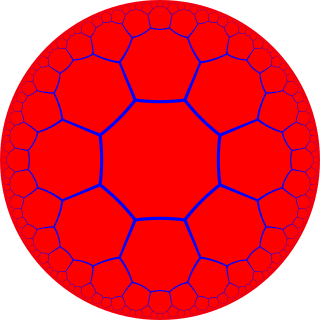Top Qs
Timeline
Chat
Perspective
Octagonal tiling
Regular tiling of the hyperbolic plane From Wikipedia, the free encyclopedia
Remove ads
In geometry, the octagonal tiling is a regular tiling of the hyperbolic plane. It is represented by Schläfli symbol of {8,3}, having three regular octagons around each vertex. It also has a construction as a truncated order-8 square tiling, t{4,8}.
This article may be too technical for most readers to understand. (May 2021) |
| Octagonal tiling | |
|---|---|
 Poincaré disk model of the hyperbolic plane | |
| Type | Hyperbolic regular tiling |
| Vertex configuration | 83 |
| Schläfli symbol | {8,3} t{4,8} |
| Wythoff symbol | 3 | 8 2 2 8 | 4 4 4 4 | |
| Coxeter diagram | |
| Symmetry group | [8,3], (*832) [8,4], (*842) [(4,4,4)], (*444) |
| Dual | Order-8 triangular tiling |
| Properties | Vertex-transitive, edge-transitive, face-transitive |
Remove ads
Uniform colorings
Like the hexagonal tiling of the Euclidean plane, there are 3 uniform colorings of this hyperbolic tiling. The dual tiling V8.8.8 represents the fundamental domains of [(4,4,4)] symmetry.
Regular maps
The regular map {8,3}2,0 can be seen as a 6-coloring of the {8,3} hyperbolic tiling. Within the regular map, octagons of the same color are considered the same face shown in multiple locations. The 2,0 subscripts show the same color will repeat by moving 2 steps in a straight direction following opposite edges. This regular map also has a representation as a double covering of a cube, represented by Schläfli symbol {8/2,3}, with 6 octagonal faces, double wrapped {8/2}, with 24 edges, and 16 vertices. It was described by Branko Grünbaum in his 2003 paper Are Your Polyhedra the Same as My Polyhedra?[1]
Remove ads
Related polyhedra and tilings
Summarize
Perspective
This tiling is topologically part of sequence of regular polyhedra and tilings with Schläfli symbol {n,3}.
And also is topologically part of sequence of regular tilings with Schläfli symbol {8,n}.
From a Wythoff construction there are ten hyperbolic uniform tilings that can be based from the regular octagonal tiling.
Drawing the tiles colored as red on the original faces, yellow at the original vertices, and blue along the original edges, there are 10 forms.
Remove ads
See also
Wikimedia Commons has media related to Order-3 octagonal tiling.
References
External links
Wikiwand - on
Seamless Wikipedia browsing. On steroids.
Remove ads







































































